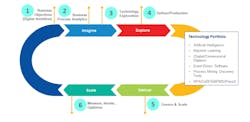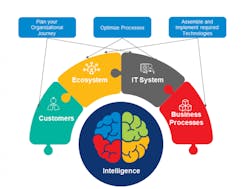Hyperautomation: The gateway to connected transformation of enterprise processes
By Somit Kapoor, vice president and global head of enterprise operations transformation at Wipro Ltd.
One thing you can say for sure about the digital transformation space when it comes to technology offerings and solutions—it is continuously transforming itself. In the first decade of the century it started with the automation of simple and structured tasks using scripts. The second decade saw the rise of robotic process automation and cognitive intelligence, which were easily scalable and customizable to business requirements. It also utilized artificial-intelligence technologies of deep learning, natural-language processing and machine learning to take reasoning based advanced decisions.
Wipro's Somit Kapoor
As we enter the third decade, the word that has gathered undivided attention is “hyperautomation.”
Most organizations are often unable to scale and take full advantage of end-to-end automation. As a result, automation projects often stall after a few initiatives; this is mainly because they either don’t have the clear roadmap for organization-wide transformation or they have made a siloed choice of technologies that limits the potential of automation.
Hyperautomation is an integrated approach to rapidly identify, vet and automate business and IT processes to enable an organization to become an intelligent enterprise. According to Gartner, hyperautomation involves the orchestrated use of multiple technologies, tools or platforms (including but not limited to, AI, machine learning, RPA, iPaaS, packaged software solutions and other types of decision, process and/or task automation tools).
Competitive pressures for efficiency, efficacy and business agility are forcing organizations to address back, middle and front-office operations. Hyperautomation is opening up a new world of possibilities and bringing businesses closer to their vision of an intelligent enterprise that is customer-centric and operationally efficient by utilizing complementary sets of tools that can integrate functional and process silos to augment business process automation.
Hyperautomation is not an end state, but rather an iterative journey composed of dozens of concurrent initiatives leveraging an extensive array of technologies over multiple years. The benefits of hyperautomation include improved revenue, operating margin, productivity, customer experience and asset utilization.
For example, hyperautomation can transform complaints-management for life-science organizations, which must report and process all product issues, adverse events, and complaints using a process that has grown increasingly regulated during the COVID-19 pandemic. An integrated hyperautomation solution will classify mails/handwritten documents and extract data attributes for case creation. It leverages robotic-process automation, artificial intelligence and machine learning bolstered by active learning for faster training cycles, natural-language processing, computer vision and optical-character recognition techniques for image processing with deterministic pattern. This ensures case completeness and quality while reducing the risk of regulatory audits.
In order to yield the maximum benefit, hyperautomation initiatives should be targeted to tangible business outcomes that address business needs, have strategic direction, and address organizational readiness. The opportunities should be evaluated with detailed analysis and redefined with the right set of tools and technologies. Ultimately, the success of hyperautomation depends on scaled delivery with the right innovation expertise at every step.



